| 1 | The world’s longest viper |
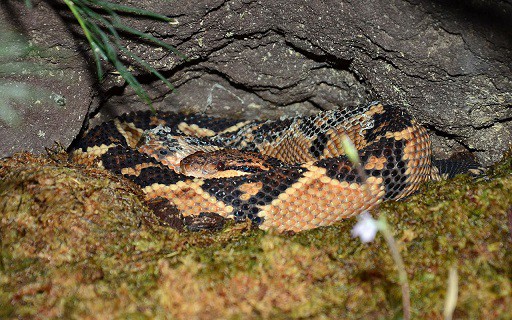
The South American bushmaster is a member of the mighty viper family (Viperadae), which has over 200 members worldwide. The 50+ rattlesnakes are part of this family, as is the UK’s adder. But only one member can be the longest, and that honour falls to the South American bushmaster (Lachesis muta).
This is a jungle species which lives across a huge swathe of South America, including Brazil, Venezuela, Bolivia, Colombia and the island of Trinidad. South American bushmasters crawl out of their eggs at 30-50cm, and average at 2-2.5 metres long in adulthood. The longest bushmaster ever recorded measured 3.65 metres, excluding the craziest village rumours. This viper is officially the longest venomous snake in the western hemisphere, and the third longest worldwide, behind the black mamba and king cobra.
Being so massive, it can be a struggle for this snake to stay camouflaged, but South American bushmasters have a crafty solution: barely moving all day. This is a lazy ambush snake which lies motionless for days in jungle foliage, waiting patiently for rodents (its main prey) to wander past.
| 2 | The jungle is its territory |
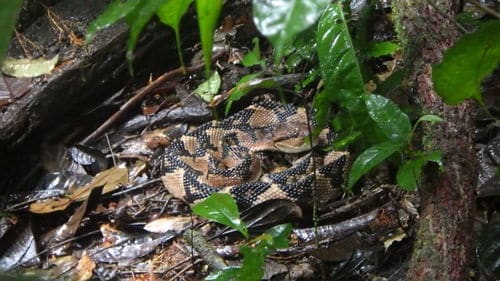
The boa constrictor inhabits various habitats, from grassland to coffee plantations. South American bushmasters meanwhile, are a true ambassador of the jungle. They’re a creature of moist forests, resting silently on the leafy floor, often exploiting the helpful disguise of a fallen log, or hiding in its hollowed out centre.
This snake doesn’t encounter humans often, being such a deep jungle dweller. But they’re sometimes spotted along narrow lanes through forests, and stray into remote farms, including palm oil, sugar cane, bamboo, cacao and banana plantations.
South American bushmasters require an average temperature of at least 24C, and rarely appear above 1000 metres in altitude. Within jungles, they prefer uplands rather than swampy riversides. This is far from a water snake, but South American bushmasters have been spotted swimming occasionally. They also have a particular liking for armadillo holes.
Despite their jumbo length, South American bushmasters are relatively light, weighing 6.6-11 pounds versus 6-20 for the far shorter Mojave rattlesnake.
| 3 | A feared snake in folklore |
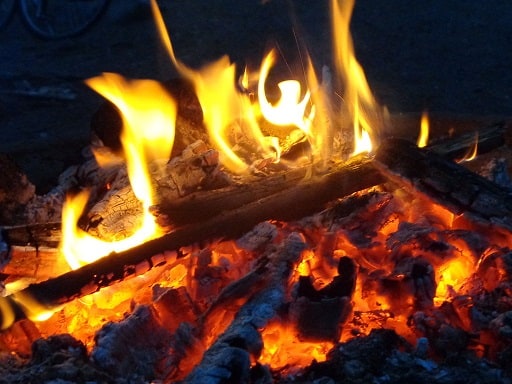
Local villages have endless superstitions about this shy yet deadly snake species. Indigenous rainforest folk call it the “fire extinguisher”, because of its unusual attraction to flames. They warn that lighting a fire in bushmaster country is practically suicide, as the normally lethargic snake will supposedly perk up and leap several metres through the air towards any flames it detects. There’s also tales of this snake stalking human beings, and even attacking passing motorbikes, after getting confused by the shining headlamps.
Some villagers call this snake “shushupe” and believe that it can transform into mammals. A classic legend involves a hunter pursuing a dying armadillo into its burrow, after a successful gunshot. The hunter pokes his arm in to retrieve his prize, but is instead greeted by the hissing face of a bushmaster. The pursued armadillo has switched to its snake form, using its last available form of defence.
The real explanation, of course, is that South American bushmasters use armadillo holes as shelter. That said, nothing has been disproven…
| 4 | Injects a massive quantity of venom |
“So long are the fangs and so deep the wounds, that there is no hope of being cured.” Those were the words of explorer Sir Edward Sullivan in 1852. Gram for gram, the bushmaster’s venom is only moderately deadly. Its LD50 score is 1.6-6.2mg in mice, compared to the African boomslang at 0.07mg, or the Saharan horned viper at 1.2mg.
Where the South American bushmaster beats the competition is in the massive quantity of venom injected. The early estimate from the 1970s was 200-411mg per dry bite, but believe it or not, this wasn’t an exaggeration. Later, more scientific estimates increased the venom yield to 500mg, with the boomslang managing just 1.6-8mg.
Other venoms have specific deadly niches, but Lachesis muta venom covers almost the whole spectrum: neurotoxic, necrotic, proteolytic, haemorrhagic, and myotoxic. It’s estimated that 1.4% of South American bushmaster bites are fatal, and a high amount of deaths occur within 45 minutes. Time is short with this snake, but the standard hospital antivenom has a high effectiveness. Typical symptoms include nausea, hypotension, sweating, diarrhoea, respiratory problems, and impaired consciousness.
| 5 | Mothers defend their eggs |
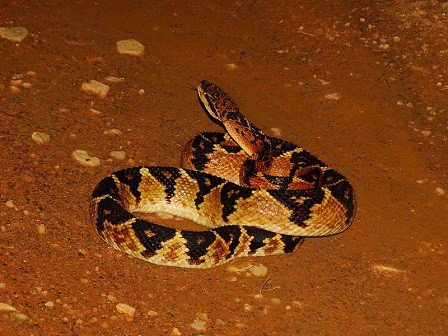
In the regions where it lives, Lachesis muta contributes 4.5-7.5% of snake bites, with one inflated statistic being 17-35%. But they also hold a friendlier record: being a rare snake to guard its freshly laid eggs.
Mother bushmasters lay 16-19 eggs at once, usually in a mammal burrow. As the babies develop, fuelled by the nutritious yolk, the mother coils around her precious egg batch, frightening off predators by her menacing presence alone. While she stands watch, the mother bushmaster will barely eat. This caring nature was first spotted in 1910 by Bronx Zoo employee Raymond Ditmars (more on him soon). The moment the eggs hatch, the mother bushmaster slithers away, ready to seek new horizons.
South American bushmasters are born with a rare feature: a neon-orange or yellow tail, designed to confuse hungry predators, possibly by mimicking other venomous creatures. These Vegas-style colours fade by adulthood. Laying eggs itself is rare among vipers, most of which lay live young (including all rattlesnake species).
| 6 | The story of Lecky |
Raymond Ditmars was born in 1876, and eventually became one of the top herpetologists of the early 20th century. In his teenage years, he became particularly obsessed with the South American bushmaster, after unwisely ordering a crate of live snakes from Trinidad. An 8 foot bushmaster crawled out, and chased the teenage Ditmars all over his bedroom, until he finally deterred it with the hard whack of a broomstick.
It took Ditmars 4 decades to capture a live bushmaster, but on September 6th 1934, he finally fulfilled his life’s ambition on the island of Trinidad (although it was actually an assistant who made the capture). Newspaper headlines rang out, saying “Ditmars Obtains Live Bushmaster. Succeeds After 30-Year Hunt“. The bushmaster was quickly dubbed Lecky, the Mahatma Gandhi of reptiles.
Lecky was stored in a first class cabin en route to New York, and two weeks later, he was on proud display in Bronx zoo. 100,000 visitors flocked to gaze on him weekly, and Ditmars himself had to stop turning up, after being bombarded with visitor questions.
| 7 | How Lecky died |
Bushmasters far notoriously badly in captivity, and it didn’t take long for Lecky to fall ill. Ditmars used every strategy to mimic Lecky’s natural habitat, like strewing leaf litter around the enclosure and keeping the humidity and temperatures to rainforest levels. But Lecky the bushmaster refused to eat, no matter how many dead rats were dangled in front of him.
Ditmars brought in Grace Olive Wiley, a middle aged snake charmer who picked venomous snakes up in her hands and whispered softly, claiming to have a special connection with them. The plan didn’t work. Finally, Ditmars used a pair of forceps to forcefeed Lecky, shoving a dead chicken into his mouth. This could have easily snapped Lecky’s spine, but “That chance seemed to be worth taking“, said Ditmars.
Lecky swallowed, and everyone breathe a sigh of relief. But 12 days later, on November 22nd 1934, Lecky was found dead in his enclosure. Medical analysis revealed parasitic worms hooked onto his heart, which he had ingested in his native Trinidad. Ditmars brought another bushmaster to Bronx zoo in 1935, this time called Cleopatra Arrima, which lasted significantly longer – nearly a whole year.
| 8 | Their fangs are long |
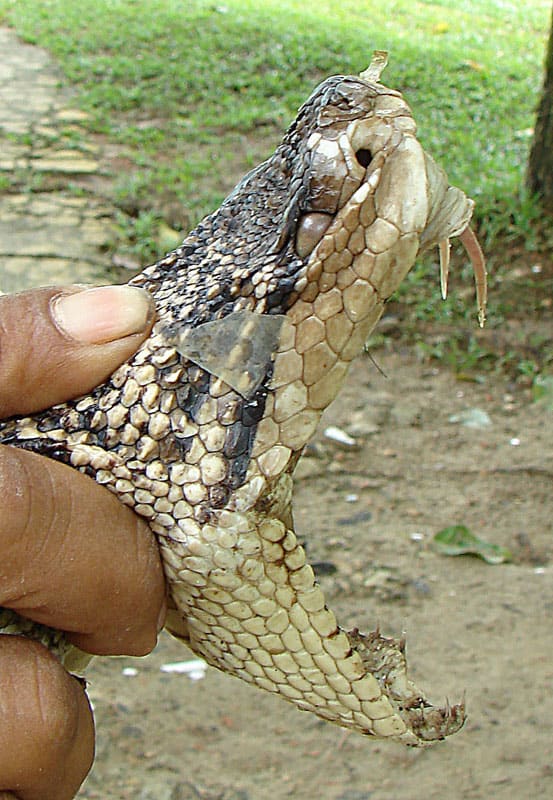
South American bushmasters don’t just have a jumbo length body. Their front fangs are viciously long, exceeding 2 inches (5cm), and just falling short of the gaboon adder’s notorious 2.5 inch gnashers. Their personality, however, is relatively shy. Bushmasters can remain coiled in the same spot for 30 days, and survive on just 10 meals per year. They’ll attack humans if seriously flustered, but just as often flee into the undergrowth, while making a distinctive low whistling noise.
While some venomous snakes release their prey immediately after biting, South American bushmasters hold on, keeping them in a prison of coils until they succumb. Their diet is mostly rodents, one favourite being the agouti, which has several species in South America and closely resembles a guinea pig.
Bushmasters also enjoy rice rats, spiny rats, squirrel rats, opossums and porcupines, occasionally venturing to small birds and frogs. Lachesis muta isn’t a strictly nocturnal snake, but they primarily hunt at night. Dusk is an easier time to spot them than dawn.
| 9 | A snake of many names |
Few snakes have as many nicknames and interesting origin stories as the South American bushmaster. The bushmaster title was already being used in 1852, as shown by explorer Sir Edward Sullivan’s quote: “The Couni Couchi or Bushmaster is the most dreaded of all the South America serpents; and, as his name implies, he roams absolutely master of the forest“.
As for the Latin name, Lachesis is one of the three fates in Greek mythology, or Moirai, the three sisters who cut the thread of life and assign all people and gods their destiny. Lachesis was the sister in control of lifespan, and there’s no doubt that the bushmaster can also influence your lifespan.
Muta, meanwhile, translates to mute, and references the bushmaster’s similar (though far larger) appearance to rattlesnakes. The bushmaster swings its tail in the same style, but produces no rattle, just a sharp rustling sound against the jungle undergrowth. Local names include shushúpe in Peru, pucarara in northern Bolivia, and makasneki in Suriname. The Peruvian name of verrugosa references its warty looking scales.
| 10 | Only two subspecies |
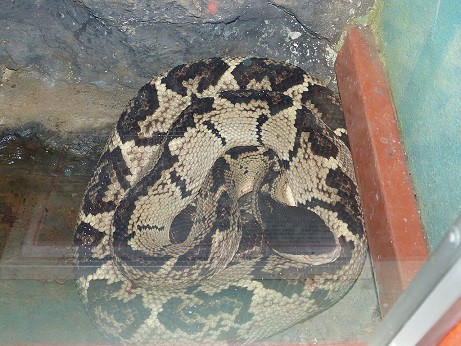
Once upon a time, the bushmaster family was powerful and had many noble strands. Its subspecies include the rare black-headed bushmaster in Costa Rica, and the Central American bushmaster which took over to the north. These snakes have extra dark scales, including the namesake black head, and climb to 1600 meters in altitude instead of just 1000 metres.
Since 2010, however, DNA analysis has revealed these bushmaster cousins to be independent species. They’re now known as Lachesis melanocephala and Lachesis stenophrys respectively. The only remaining Lachesis muta subspecies are the main one inhabiting the Amazon rainforest, and the Atlantic forest bushmaster (L. muta rhombeata). This second version dwells solely in the coastal forests of southeast Brazil, including the southern Rio Grande and Rio de Janeiro. Meanwhile, the boa constrictor boasts 6-11 subspecies.
It’s not surprising that scientists were confused for so long. South American bushmasters and the two lost subspecies look extremely similar, with thin black zigzag covering a beige or pink base of scales, usually with a creamy yellow belly.
| !! | BONUS: more family facts |
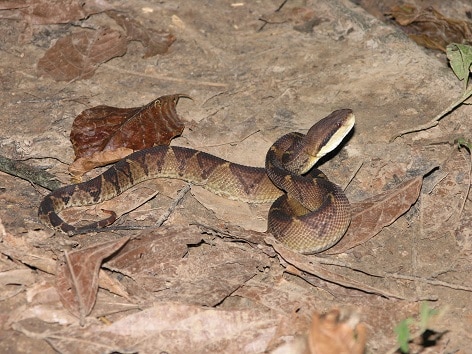
As of 2023, the bushmaster family stands at four species:
South American bushmaster – divided into two species as mentioned above.
Central American bushmaster (Lachesis stenophrys) – the second most common, ranging from Panama to Nicaragua.
Black-headed bushmaster (Lachesis melanocephala) – the least common, inhabits southern Costa Rica exclusively.
Chocoan bushmaster (Lachesis acrochorda) – inhabits Ecuador, Colombia, and eastern Panama.
Hard-working scientists have gradually narrowed down the timescales for these species. Despite looking similar, it turns out that the two Central American species split from the two South American species 6.5-18 million years ago. Even the black-headed bushmaster and Central American split an estimated 4-11 million years ago. Both are found in Costa Rica, but don’t overlap, being firmly separated by the towering Cordillera de Talamanca mountain range (max altitude 3820 metres).
Meanwhile, the Chocoan bushmaster is separated from the South American bushmaster by the Andes mountains. Originally, it was separated from central American bushmasters by rising sea levels and open ocean, which cut off South America. 3.5 million years ago, the Panama land bridge reformed, and the Chocoan and Central American bushmasters were reunited, but were now too genetically distinct to interbreed, and remained as separate species forever.
As for the two South American bushmaster species, the Atlantic forest version (eastern Brazil) split far more recently: just 300,000-800,000 years ago. In the Pleistocene, conditions were far cooler, creating swathes of forest habitat they could use as a corridor to the Atlantic. As the climate warmed, these were cut off.